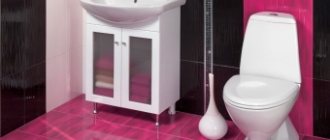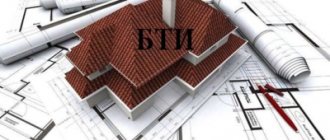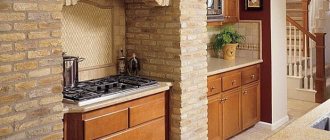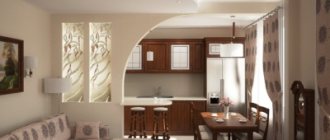What is allowed
Let's start with the work that is permissible as part of the redevelopment of the bathroom. It is easy to obtain permission from the administration for them.
Combine or separate a bathroom
By combining, you can create a spacious bathroom, and by dividing, on the contrary, you can separate the bathroom and toilet.
Features of this redevelopment:
- To combine the bathroom, you need to dismantle the partition between the rooms. Typically, such a partition is not load-bearing, most often made of plasterboard. It can be broken down to the base, followed by laying a waterproofing layer on the resulting “ditch”. The load-bearing wall between the bathroom and toilet cannot be demolished.
- To separate the bathroom, you will have to build a partition from moisture-resistant materials. This option is appropriate if the area of the combined bathroom and toilet is sufficient to separate them. The construction of new partitions is approved without problems in 99% of cases.
When combining a bathroom, you can install it in a free space, for example, a bidet or a washing machine. You will also have to resolve the issue of blocking the doorway, which previously led to the bathroom or toilet.
A prerequisite is the preservation or installation of a door threshold. Its height according to SNiP must be at least 15-20 cm (clause 4.8 SP 29.13330.2011). An alternative option is to make the floor level in the bathroom and toilet lower than in the rooms. This is a safety requirement so that in the event of a flood in the bathroom, water does not spread to the rest of the premises.
Enlarge the bathroom due to the corridor
Expansion of the bathroom and toilet due to part of the corridor is the second most popular bathroom redevelopment in Khrushchev-era buildings.
The law allows such an increase at the expense of non-residential premises. These in the apartment include a corridor, a pantry, and a built-in closet. However, if the door to them comes from the living room, these premises will not be considered non-residential. This means that it will not be possible to expand the bathroom with them. The door to the “wet areas” should open into the corridor, and not into the living room.
Move the bathroom to the hallway
It also does not contradict the norms of SanPiN and SNiP.
A bathroom or toilet can be installed in the corridor. But for this you will have to comply with some requirements:
- Construction work must be coordinated with the housing authority based on the bathroom redevelopment project.
- Only partitions are allowed to be moved. If the wall is load-bearing, it cannot be moved to move the bathroom or toilet into the hall.
- The owner will have to install the necessary communications under the location of the future bathroom. We are talking about sewers and risers. In this case, you need to hide communications in the walls. For this, a plumbing box with an inspection hatch is usually used to access the pipes.
- A layer of waterproofing must be laid. You also need to think about the “threshold” or floor level of the restroom.
Moving the bathroom to the corridor is practiced in spacious apartments, the same “Stalin” style. Including for the purpose of arranging a second bathroom and toilet.
Move plumbing and pipes
Changing the location of plumbing and utility equipment is considered a remodel.
The toilet, sink, bathtub and shower are noted in the BTI explanation for the apartment’s registration certificate. Changes in the location of devices must be agreed with the local government. If the changes are not significant, you can get by with a simple sketch. In other cases, a bathroom remodeling and renovation project is ordered.
Replace a shower cabin with a bathtub, and vice versa
The plumbing cabin is a solid building structure. It is noted in the BTI plan. Therefore, to replace a shower stall with a bathtub, or vice versa, it is necessary to prepare a bathroom remodeling project. You should first consult with architects to see if it is possible to remove the plumbing cabin without damaging the premises.
How to legalize redevelopment through court
How to legalize redevelopment in an apartment if it has already been done independently
Cladding and interior design
The last stage - cladding and final interior design - is best carried out after several days of observing the operation of all communication systems in real action. When the combined bathroom design is technically ready, it will be the most exciting activity: installing mirrors and selecting lamps, choosing colors and shades, furniture and accessories. However, all these details were thought out in general terms at all stages of the redevelopment: materials for plumbing, the general color scheme and style of the room must be combined with the shapes and sizes of all details.
Interior of a combined bathroom
For the interior of a bathroom, independently combined with a toilet, to be finally ready, it takes at least 14-20 days:
- 2-3 days for dismantling;
- 2-3 days for installation of water supply and sewerage;
- 3-4 days for installation of plumbing equipment and its testing;
- 1 day for installation of electrical systems;
- 2-3 days for floor screed;
- 2-3 days to prepare structures for the ceiling and walls;
- 2-3 days for cladding and final installation of all equipment.
In modern conditions, renovating a bathroom on your own rarely seems like an impossible task, but you need to understand that the effort that will have to be spent on remodeling must be significant and include certain skills in several areas: plumbing, electrical, construction and repair.
What is prohibited
Along with the permitted activities for remodeling the bathroom and toilet, there are also those that are prohibited. Let's consider what work violates construction and sanitary standards.
Expand the bathroom at the expense of the living room or kitchen
Residential premises in an apartment building repeat each other's layout vertically. If you enlarge the bathroom at the expense of the living room, the room will be located above the conventional bedroom of the neighbors below - and this will worsen their living conditions. Flooding of the “wet zone” threatens to flood the people living below. Therefore, clause 3.8. SanPiN2.1.2.2645-10 and clause 9.22 SP 54.13330.2016 directly prohibit expanding the bathroom at the expense of the living room and kitchen.
But there are three exceptions:
- Remodeling a bathroom in an apartment on the first floor.
- Expansion of the bathroom and toilet at the expense of a room in a two-level apartment. For example, you have combined two living spaces on the 2nd and 3rd floors into one and want to enlarge the bathroom of the upper apartment at the expense of part of the bedroom.
- The location of the apartment is on any floor, provided that there are non-residential premises underneath (office, store, fitness, restaurant, warehouse, basement).
But even the fulfillment of one of these conditions does not relieve the apartment owner from the need to order a bathroom remodeling project.
Move the bathroom into the kitchen
Similar requirements apply in the case of converting a kitchen into a bathroom and toilet. If the neighbors below do not have the same redevelopment, then you will not be able to do it either. With the exception of cases of living on the ground floor, in a two-level apartment or above non-residential premises in the house.
Let's sum it up
When it is not possible to purchase new housing with an improved layout, people strive to improve what they have.
And if, for example, after some time the dining room can be easily converted into a bedroom, and the children’s room into an office, then this will not work with the toilet; they are being modernized seriously and for a long time.
What documents are needed to redevelop an apartment? How to remodel an apartment legally? Find out here.
Is it possible to do redevelopment if the apartment is under mortgage? Read on.
If the owner has already carried out reconstruction without approval, then it will be much cheaper to legalize it as quickly as possible, before all the work performed becomes known to the Housing Inspectorate and sanctions in the form of fines, court decisions and other troubles fall on the owner of the apartment.
How to coordinate the redevelopment of a bathroom and toilet in 2021
Coordination of work must begin before the bathroom is expanded or moved to another room. Otherwise, you will have to legitimize the repair “retroactively.” And it is not a fact that this will be implemented in practice.
Procedure
The steps may vary depending on the region, type and series of the house. We will indicate the main stages that are inherent in agreeing on the redevelopment of a bathroom in an apartment:
- First of all, you need to consult the redevelopment approval department of the administration in your area. For example, in Moscow this is the Moscow Housing Inspectorate, and in the regions - the departments of architecture and urban planning. Next, get advice from the design office regarding the upcoming redevelopment of the bathroom.
- Order a technical passport or an explication and floor plan of the apartment. They are issued by the BTI on the basis of a passport and a document on ownership of the apartment.
- Conclude an agreement with the design organization. She will be tasked with making a bathroom and toilet remodeling project in accordance with your ideas. The organization must have SRO permission to develop project documentation. You can check if you have permission on the Nostroy website. After concluding a contract, a company engineer will visit the site, after which specialists will prepare a project for redevelopment of the “wet areas”. A technical opinion may also be required.
- Submitting an application for project approval. Contact the nearest MFC, where they will accept your application and documents, after which they will be forwarded to the housing authority for consideration.
- Obtain permission to remodel the bathroom.
- Beginning of construction work within the framework of the drawn up redevelopment project. Deviation from the plan is prohibited. It is better to entrust the repair to a construction company with SRO approval - in this case, they will be able to lay a layer of waterproofing themselves, generate hidden work reports and fill out a construction work log
- Write an application for the issuance of a certificate of completion of redevelopment. The application and documents are submitted to the MFC, from where they will be forwarded to the architecture department. Next, a representative of the government agency will contact you and agree on the date and time of the repair inspection.
- Submit the redevelopment to the inspection commission. It usually includes an engineer from the supervisory authority. On your side there should be representatives of the construction team and the design bureau. If the repair complies with the project and meets all standards, the inspector draws up a report on the completion of the redevelopment. It must be signed on the spot, but collected later at the housing authority.
- Order a new registration certificate. With a completed certificate of completed redevelopment, you need to contact the BTI and invite a technician. He will take measurements of the bathroom. Based on these measurements, the Bureau will make changes to the technical records, and you will be issued a new registration certificate for the apartment.
- Make changes to cadastral registration. The final stage is to contact the MFC with an application to invite a cadastral engineer. He will take measurements and transmit the information to the Unified State Register of Real Estate. Next, government agency specialists will enter information about the redevelopment into the cadastral register. The owner will only have to receive a new extract from the Unified State Register of Real Estate.
Individual stages may change, but in practice, the procedure for approving the redevelopment of a bathroom looks exactly like this.
Required documents
Now let's go through the documents that are needed to obtain permission to expand or combine the bathroom and toilet.
The list is as follows:
- an application on behalf of all apartment owners, and if it is not possible to come to the MFC all together, a power of attorney is drawn up for one person - he will deal with all the paperwork;
- title documents for the apartment (donation agreement, certificate of inheritance, privatization);
- floor plan and explication - included in the technical passport of the apartment;
- ready-made project for redevelopment of “wet areas” + technical specifications on the safety and permissibility of work;
- an agreement on designer's supervision, a production work log, a certificate of admission of the SRO company and other documents included in the project documentation.
In addition, other documents may be required. We are talking about a bank permit, a certificate from Gorgaz, a notarized power of attorney, and a permit from an architectural authority. The list is individual and may change.
Cost of approval
There is no need to pay for the issuance of a redevelopment permit - the service is free.
The costs include the preparation of a bathroom and toilet remodeling project. It is cheaper to arrange the demolition of a partition or the relocation of plumbing fixtures. The situation is more complicated with moving partitions and expanding the bathroom at the expense of the corridor. The cost of the project ranges from 5,000 to 70,000 rubles. Technical conclusion is paid separately.
Changes resulting from redevelopment in the BTI and Rosreestr will cost from 5,000 rubles and more.
Deadlines
Coordination of renovation work in the bathroom and toilet takes on average from 3 to 6 months. Of these, 45 days will be considered for the application for permission to remodel the bathroom - by virtue of clause 4 of Art. 26 Housing Code of the Russian Federation.
You need to wait another 10 days for changes to be made to the BTI database and about the same number of adjustments in the cadastral register.
The period for issuing permission for redevelopment is 1 year, with the possibility of extension for another 6 months. It cannot be extended any further.
Problems with illegal redevelopment
Considering the complexity and fairly high cost, some owners prefer to carry out unauthorized redevelopment, without having it agreed upon or legitimized anywhere. This is a serious mistake. To begin with, it will be almost impossible to sell such housing or transfer it as collateral to the bank.
In addition, the owner of the apartment will be fined in the amount of 2000-2500 rubles and given an order to bring the housing into compliance with the technical passport. If you ignore this instruction, after a while the housing will simply be taken away and sold at auction. And everything is strictly according to the law (Article 29 of the Housing Code of the Russian Federation).
Since the approval procedure is highly complex, in many cases it is impossible to do without the competent assistance of a lawyer. At a free consultation, specialists will talk about the main and most important problems relevant to such situations. They can also represent the client’s interests in the MFC or court.
FREE CONSULTATIONS are available for you! If you want to solve exactly your problem, then
:
- describe your situation to a lawyer in an online chat;
- write a question in the form below;
- call Moscow and Moscow region
- call St. Petersburg and region
Save or share the link on social networks
(
1 ratings, average: 5.00 out of 5)
Author of the article
Natalya Fomicheva
Website expert lawyer. 10 years of experience. Inheritance matters. Family disputes. Housing and land law.
Ask a question Author's rating
Articles written
513
- FREE for a lawyer!
Write your question, our lawyer will prepare an answer for FREE and call you back in 5 minutes.
By submitting data you agree to the Consent to PD processing, PD Processing Policy and User Agreement
Useful information on the topic
1
How to sell an apartment with illegal redevelopment
Sale of an apartment without the consent of the competent structures produced in it...
Unauthorized redevelopment when buying an apartment - consequences
In some cases, the new owner of the apartment finds out about the crime…
2
Sample apartment redevelopment project for approval
It is, of course, quite possible to remodel an apartment without a project, but the changes made...
15
Redevelopment in a private house - do you need permission?
Owners of private houses located on their own land have fewer restrictions...
Redevelopment and reconstruction: what is the difference
Making changes to an apartment almost always requires approval, be it…
1
Redevelopment of an apartment - what is possible and what is not
The standard layout of a living space (apartment) does not always suit the owner...
What are the consequences of illegal bathroom and toilet remodeling?
Unauthorized transfer or expansion of the bathroom is fraught with trouble. If the supervisory authority learns about the violation, the owner will be visited with an inspection, following which they will be obliged to either legalize the repair or return the bathroom to its original state. At the same time, they will issue a fine for unauthorized redevelopment - from 2,000 to 2,500 rubles (Part 2 of Article 7.21 of the Code of Administrative Offenses of the Russian Federation).
If the neighbors below suddenly flood, the culprit will have to compensate for the damage from his own pocket. In this case, it is necessary to prove that the flood occurred due to illegal redevelopment.
Housing with unauthorized alterations in the bathroom is difficult to sell. Buyers will start asking for a discount. And banks do not approve loans for the purchase of apartments with unauthorized changes.
Dismantling works
Bathroom renovation begins with dismantling work. This is the dirtiest and most labor-intensive stage. Usually it can take 2-4 days, and the possibility or impossibility of moving out the owners of the apartment during dismantling plays a big role: the need to use water supply and sewerage communications can slow down the progress of work.
Dismantling works include:
- dismantling doors and slopes;
- possible dismantling of electrical wiring;
- removal of old cladding;
- complete or partial destruction of the partition wall;
- complete dismantling of water supply and sewer systems.
Important! Typically, 30 to 50 bags of construction waste may be required during dismantling.
Lawyer's answers to private questions
Is it possible to coordinate the redevelopment of a bathroom according to a sketch?
Yes, if you are planning minor changes to the layout of the bathroom and toilet. For example, moving a toilet to a new location.
Can I move the bathroom to the living room? Under my “Khrushchev” there is a non-residential premises on the first floor.
Sanitary and building codes do not prohibit this option. The main thing is that a project is drawn up for the redevelopment. If it is approved by the local administration, then everything is in order and the transfer is permissible.
Is it necessary to re-install waterproofing when remodeling a bathroom?
This requirement is noted in SNiP 2.03.13-88 “Floors”. When enlarging a bathroom or restroom, laying a waterproofing layer is mandatory. It protects the floor structure from water leaks. Lack of waterproofing in the bathroom and toilet is a serious violation. Firstly, such a redevelopment will not be approved for you, and secondly, there is a risk of flooding the neighbors below. Also remember that the installation of waterproofing is documented in hidden work certificates. They are signed by the author of the redevelopment project, and subsequently examined by an inspection commission. Without these acts, you will not be given a certificate of completed bathroom remodeling.
Do I need a project if I want to install a washing machine, drying cabinet and heated towel rail in the bathroom?
No, because these objects are not indicated on the BTI plans. A washing machine can be installed without approval from the administration. Similarly - a heated towel rail and a drying cabinet.











